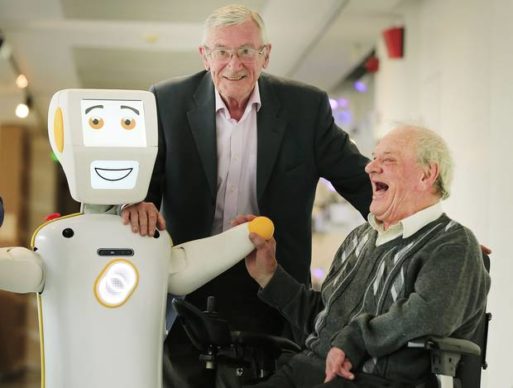A team of researchers from Trinity College, Dublin, revealed a new version of their “Stevie” robot last month. Its main function is to interact with seniors and to provide a level of support for those living in both care homes and by themselves.
Loneliness among the elderly is a common and growing concern around the world. Many seniors who never married or whose spouses have died live alone, and it’s not always possible to live with other family members. People can feel lonely even when surrounded by others in care homes. Artificial intelligence (AI) can help mitigate these feelings of loneliness or isolation. Stevie II is a prime example of this.
The impetus behind the original Stevie robot was to assist elderly people with daily tasks, such as reminding them to take their medication. But after further research, the team discovered that people seemed to enjoy the robot’s company. Many said that he was fun to talk to and made them feel better.
“When we brought Stevie around people, rather than them expecting him to pick something up for them, they really just wanted to interact with Stevie, have a conversation with him or get some information from him,” said Niamh Donnelly, one of the AI researchers. “That turned our focus towards the more social aspect of it.”
Stevie II has face and voice recognition, so it’s able to address people directly by name. And it’s able to understand, reply to and carry out certain commands. Advanced sensing technologies like laser rangefinders, depth cameras and vision sensors combine to aid Stevie in his interactions with both humans and the proximate environs. The robot also has two separate screens for his mouth and eyes, which enable him to display numerous expressions. This helps to humanize the technology behind Stevie II.
Not Solely A Social Benefit
Stevie II certainly can become a “friend” of sorts for elderly people dealing with a dearth of social interactions. But he offers much more than a chummy ear to speak to. Stevie II can assist seniors (particularly those with a disability) in numerous helpful ways that can improve their overall quality of life and aid during an emergency.

Credit: irishnews.com
Tony McCarthy was involved in a focus group study for Stevie II. He mentioned that the robot provides an added sense of security.
“I have asthma and he reminds me what medications I have to take,” he said. “More importantly, the capacity the robot has to directly make a phone call to emergency services to bring help if a person is incapacitated, I think that is very positive. Especially for people who have a fall, and couldn’t reach their panic button, with Stevie, he would directly be able to call emergency services.”
The technology used here is similar to other new products designed specifically for elderly people who live alone. Where Stevie II differs from other technologies is it offers that social aspect in addition to the health and security benefits. The research team is planning several more pilot tests of Stevie II over the coming months.
AI will never be able to fully take the place of real human interactions. However, robots can be beneficial for people who don’t get much in the way of social contact. If a robot can make someone feel less lonely and happier, we should embrace that.

 Irish Researchers Reveal “Stevie II” Robot to Combat Loneliness in the Elderly
Irish Researchers Reveal “Stevie II” Robot to Combat Loneliness in the Elderly



 Losing Her Constant
Losing Her Constant

 ”The Snow Sister” Directed by Cecilie Askeland Mosli
”The Snow Sister” Directed by Cecilie Askeland Mosli














